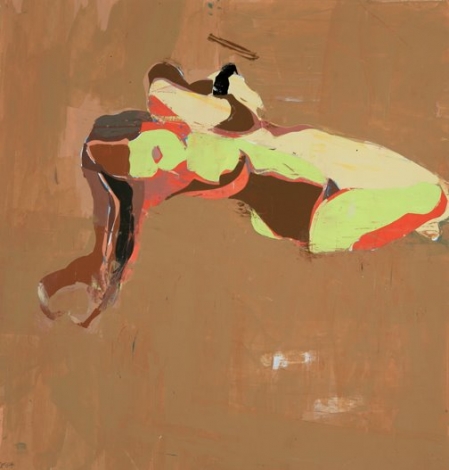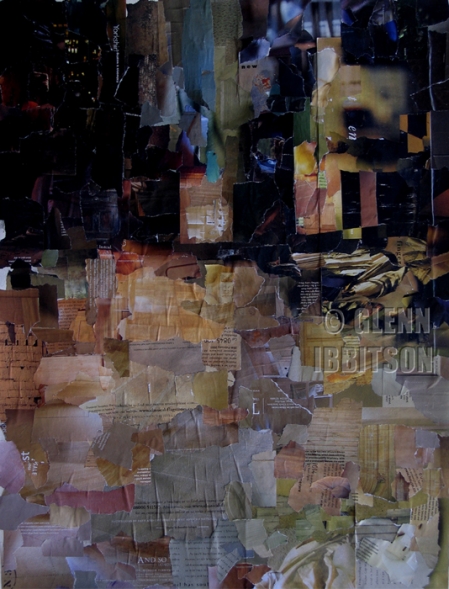
It was while researching collage references online that I discovered the work of Kim Frohsin, a painter based in San Francisco. Her pieces stood out from the general montage of mediocrity. They each looked as if they had been considered and thought through to a satisfying conclusion. I sought out more references to her art and was delighted to find that she was a figure painter of considerable talent. However, as I read about her, a theme emerged which seemed at variance to the images I was uncovering. The art of Richard Diebenkorn was a persistent reference point, with which Frohsin’s paintings were being unfavourably compared.
Stephen Jay Gould in one of his reflections on natural history reproduced in his collection of essays; “Bully for Brontosaurus”, examines the case of the “Creeping Fox Terrier”. The breed was [mistakenly, as it turned out,] used in an early paleontological tract as a size comparison for an extinct lineage of small horse. This comparison became standard in natural history textbooks, passing from generation to generation, because subsequent writers simply accepted this statement as fact and failed to question its veracity through first hand observation. I feel the same thing is happening with the connection between Frohsin and Diebenkorn; critics are re-treading the writings of their peers and not looking afresh at the work they are reviewing. Why? Because it’s so much easier for them to write this way; word-smithing without the encumbrance of examining the art for themselves.
The connection between Frohsin and Diebenkorn is straightforward. She moved to California in 1979. By living in San Francisco at this time, she was exposed to the art of the Bay Area Figurative Group; Diebenkorn, Park, Oliveira, and Bischoff. Frohsin’s work was influenced, much as a student is influenced by any tutor in any academic activity. In the early 1990’s, Frohsin’s work began to be exhibited alongside Diebenkorn’s work and other Bay Area painters.
LOOK AT THE ARTWORK
Richard Diebenkorn’s abstract paintings are marvellous; his figure painting less so. His move to figuration in the late 1950’s was overvalued at the time simply because there just wasn’t enough good representational art to balance the proliferation of abstract art in its myriad forms. Any art with a figure as its focus was bound to be welcomed as relief by a niche audience who secretly craved the recognisable; some narrative in painting, no matter how tenuous.
LOOK AT THE ARTWORK

In fact, the paintings are pretty weak. Unsupported by concentrated, direct observation, they lack that small yet significant bit of detailed painting which might have anchored the drifting approximations and created the visual tension such paintings require. The major signifiers of human expression with which the audience can engage are largely absent: hands have no more expressive form than unoccupied gloves in a frost, and faces are not those of a living, breathing model, but of curious modernist hybrids pre-packaged by Matisse and Picasso. In his hands, pigment is forced, rather than co-opted, to perform the task of depicting convincing, plastic form. It proves an unwilling slave.

Diebenkorn’s real talent, abstract organisation, shines through in “Figure on a Porch” 1959. Here the figure is formalised, absorbed into a composition which is organised on a grid, intersected by diagonals. The spaces between are infilled with variegated areas of sumptuous paint, applied with great dexterity. It is built on the same strong formal principles as the impressive Ocean Park series.

The figure gradually becomes a vestigial organ in Dibenkorn’s painting; in Frohsin’s, it is the beating heart of her practice.
Why does such an invidious comparison continue to be made between these two artists? Frohsin’s last obviously Bay-influenced paintings date from the 1990’s. It is how these stylistic foundations have been built upon, de-constructed and modified with time and the accumulation of independent experience, which matters. Frohsin shook off any direct influence years ago. It could take her only so far; a more concentrated relationship with the model was required to propel her towards where she wanted to go. Observational skills needed practice; her drawing skills had to be extended; pushed beyond what she already had at her disposal. What Frohsin is producing now, Diebenkorn couldn’t approach, because what are now her core skills in draughtsmanship, far exceed anything he ever had in his repertoire.
LOOK AT THE ARTWORK


It is at once rigorous and disciplined, yet playful and carried along with an obvious passion for colour. Her vision is translated through confident line and bravura paint application. A desire to grasp illusionistic form is held in tension by an acknowledgement of basic two-dimensional organisation. Refined tertiary hues carefully balance brash areas of super-saturated colour.
I began this ramble by recalling Kim Frohsin’s paintings. I conclude with a note to art critics. It is your duty to analyse work with rigour and clarity; unclouded by the prejudices and accepted opinions of your predecessors. If you are unable to do this, the apparatus is now freely available for a public interested in visual art to bypass your views altogether, and to enter into direct dialogue with the artists themselves through their websites and associated blogs. These provide an opportunity to engage with the practicioner, [perhaps even to arrange a studio visit] before that artist’s ideas are warped or skewed by even the most well meaning and erudite of interlocutors.
LOOK AT THE ARTWORK…..
Glenn Ibbitson February 2009
http://glennfineart.com
Kim Frohsin
http://www.kimfrohsin.com
Stephen Jay Gould
Bully for Brontosaurus: further reflections in natural history 1990




























